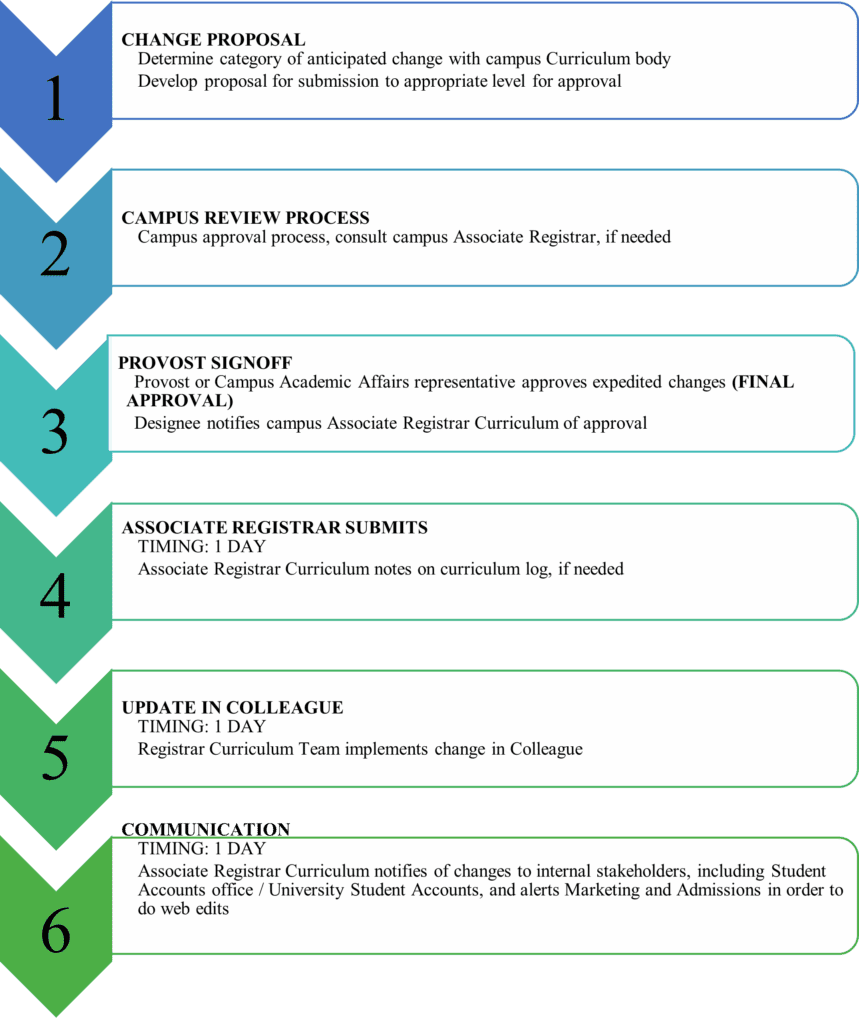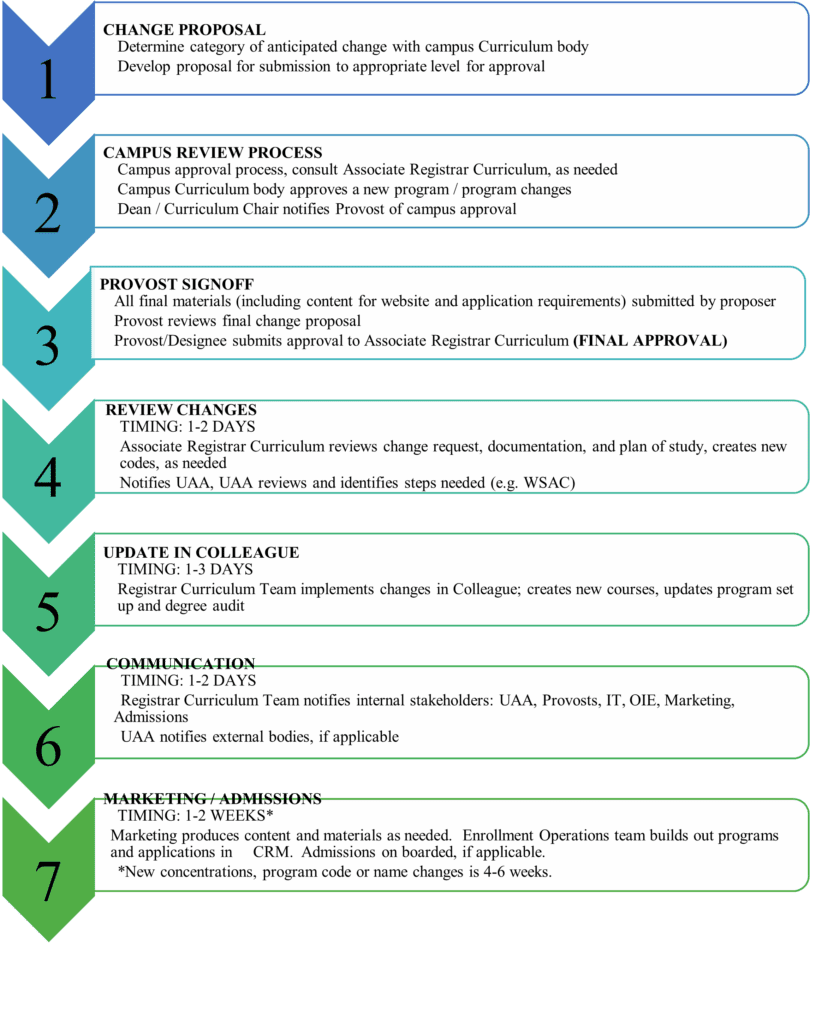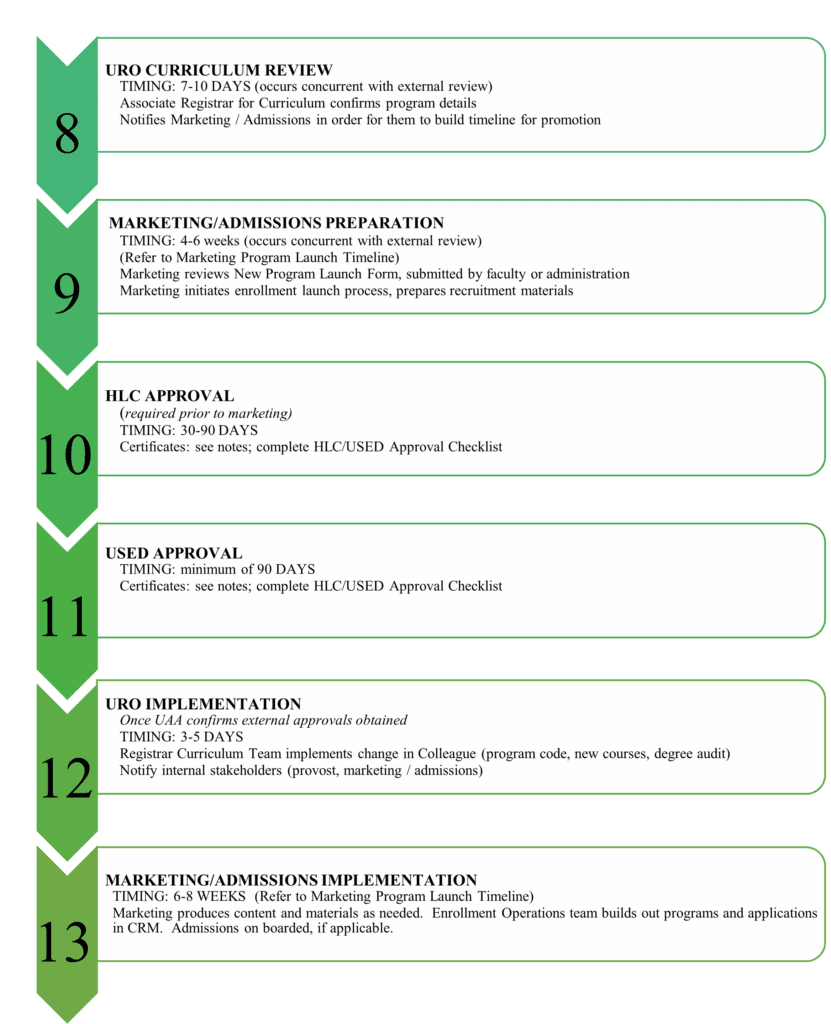AU Curriculum Handbook: Section Two
SECTION ONE:
Overview of Curriculum Development
Curriculum Defined
Overview of Development Process
Proposal Submission
Who to Contact For Help
SECTION TWO:
Antioch University Curriculum Change Process
Purpose of the Academic Change Approval Process
Guiding Principles of the Academic Change Approval Process
Curriculum Change Timelines
Curriculum Change Process Levels
Expedited Review
Internal Review
External Review
Certificate Programs
SECTION THREE:
Curriculum Details
Curriculum Policies
Antioch University Curriculum Elements
Proposal Details
SECTION TWO:
Antioch University Curriculum Change Process
This section outlines how faculty at Antioch University initiate a curriculum proposal and bring it through the approval process. It includes visual representations of the change process, as well as additional resources for those proposing new curriculum or curriculum changes. These include guides and resources in creating change proposal, an outline of contacts for questions about the process, and examples of the curriculum proposal and change forms. At the time of publication of this handbook, references are made to campus-based curriculum practices. The handbook will be updated to reflect any school-based practices once they are finalized.
Purpose of the Academic Change Approval Process
University academic policies as well as accreditation (Higher Learning Commission or HLC), state, and federal regulations require that the University establish and follow internal and external review and approval processes to assure adequate oversight of institutional operations. The purpose of this process is to assure efficiency, compliance, communication, and coordination across the university and to assure compliance with external governmental regulations and accreditation guidelines.
Guiding Principles of the Academic Change Approval Process
- Speed to Market
- Compliance with state, federal, and accreditation regulations
- University oversight
- Involvement of the appropriate individuals at the appropriate times
This document summarizes processes for curriculum change at Antioch University and provides a visual map for users. More detailed official policies and documents are referenced throughout this guide. Those who initiate curriculum change should refer to those documents.
Generally speaking, additions and updates begin with the program faculty. These ideas are discussed with the relevant provost and approved by the relevant curriculum body.
Once this level of approval is obtained, the associate registrar submits the documentation to the University Curriculum team for review or processing. Any external approvals will be obtained by University Academic Affairs (UAA) before University Registrar’s Office (URO) implements the changes. Once the changes have been made, URO will send out email notifications to all relevant parties.
Curriculum updates and new initiatives need to be reviewed by AU campus and university bodies for approval. For substantive changes, external review is also required, such as a new program, new degree, or new teaching site. See also the glossary section for definitions.
See the below for more details, including the approximate timing, needed steps and materials, and visual workflows for each of the curriculum processes.
- Expedited Review (registrar level changes)
- Internal Review (university level changes)
- Internal and External Review (substantive changes), which includes additional required information for New Certificates
Curriculum Change Timelines
Curriculum changes vary in implementation time. There are three typical timeframes that correspond to the different change levels. These timeframes are for the university implementation work (registrar, admissions, marketing, web, external review) which takes place after the provost approval.
Expedited changes (registrar level changes) take 2-3 business days, upon provost approval. University level changes (internal review) typically take 4-7 business days, upon provost approval. Substantive changes (requiring external review as well as ULC/BOG approval) may take from 3-12 months, upon provost approval.
Implementation timelines may shift if multiple complex proposals are approved at the same time.
Curriculum Change Process Levels
At the time of publication of this handbook, references are made to campus-based curriculum practices. The handbook will be updated to reflect any school-based practices once they are finalized.
The curriculum change processes are identified by the highest level of review or approval to be implemented. Each change needs provost sign off to begin implementation. Since proposal timelines may vary, the approximate timing for these changes is based on the time required after provost approval.
To accommodate multiple ways of knowing, and to represent the complexity of the process, the curriculum change process is represented in three ways: a text-based explanation, a linear visual, and looping (simultaneous, co-occurring) visual.
For reference of the visuals, internal and external stakeholders are defined as:
- INTERNAL STAKERHOLDERS: University – Admissions, Marketing, Finance, Financial Aid, Reporting, Provost, Campus Contacts
- EXTERNAL STAKEHOLDERS: HLC, DOE, WSAC, BPPE, ODHE, and NHDOE
Expedited Review (Registrar Level Changes)
This process is for changes that require minimum review and may not require full curriculum committee review. These changes must go to the university registrar’s office to be implemented. This category of change includes minor changes to courses or course restrictions. The processing time for these changes is typically 2-3 days after the provost signoff.
For changes requiring Expedited Review
- Determine category of anticipated change with Provost/Curriculum Body (see examples below)
- Complete campus-based curriculum change processes
- Provost reviews and grants final approval
- Submit approved change documentation to University Associate Registrar (on campus)
- Change implemented by URO in Colleague
- Notifications by URO to admissions, finance, and marketing, if applicable
Examples of changes requiring Expedited Review
- Changes in course prerequisites
- Change in registration restrictions
- Change in other course fields (e.g., title*, number*, descriptions*, capacity, prerequisites)
*Changes that affect degree requirements may require external notifications (such as WSAC)
Expedited Review (Visual)
TIMELINE: 2-3 DAYS AFTER PROVOST SIGNOFF PDF

Internal Review (University Level Changes)
This process is for changes that require internal review, which may require approvals from campus curriculum committee or UAA. This category of change includes new courses and non-substantive changes to existing academic programs. The processing time for these changes is typically 4-10 days after the provost signoff.
For changes requiring Internal Review
- Determine category of anticipated change with Provost/Curriculum Body (see examples below)
- Complete campus-based curriculum change processes
- Provost reviews and grants final approval
- Submit approved change documentation to University Associate Registrar for Curriculum
- University Associate Registrar for Curriculum submits approved change documentation to University Academic Affairs
- URO implements change in Colleague
- Notifications to admissions, finance, and marketing, if applicable
- Receive confirmation of University external notification, if needed
Examples of changes requiring Internal Review
- *New courses
- Changes in course delivery mode (F2F to HYB)
- Changes in fewer than 50% of courses in program, including program delivery mode (F2F to HYB)
- Change in course sequencing
- Change in degree requirements
- Change in program title
- **Addition of a new location (domestic or international)
- **Addition of concentration (this is a new program for Marketing/Admissions)
- **Addition of non-title IV, non-credit certificate (continuing education certificate)
- Suspension of recruitment for academic program
- **Cancellation or suspension of program
- **Closure or suspension for more than one term of any location
- Initiation of agreement with unaccredited institution outsourcing less than 25% of credits
- Initiation of agreement with accredited institution outsourcing up to 50% of credits
- Offer of new or existing program where 50%+ of courses are distance or low-residency
NOTE: Some of these examples may not require curriculum committee review, and may be presented directly from program to relevant provost. This is determined by the curriculum committee body.
*This process includes new courses, not a new section of a special topics or experimental courses. The special topics or special section offerings should only be offered twice before submitting the course as a new course to the curriculum committee.
New courses may be developed as stand-alone offerings, not specifically associated with a program or certificate. These are subject to the curriculum committee review process.
**California, Washington, and Ohio campuses must receive written notice from University Academic Affairs indicating proof of approval by CA Bureau of Private Postsecondary Education (BPPE), Washington Student Achievement Council (WSAC), or Ohio Department of Higher Education (ODHE), respectively, before implementation.
For Antioch University Seattle: AUS personnel will work with UAA to notify WSAC/SAA when new courses affect required components of currently authorized programs (replace existing courses, additional required courses, etc.).
Internal Review (Visual)
TIMELINE: 4-21 DAYS AFTER PROVOST SIGNOFF PDF

External Review (Substantive Changes)
This process is for changes that require both internal and external review. The internal review includes approvals from campus curriculum committee, provost, UAA, or UAC, and in addition requires review and approval from external bodies, such as HLC, USED, BPPE, WSAC, or ODHE. This category of change includes substantive changes or additions to academic programs, such as new programs (new to university and/or new to the state in which it is offered), new certificates, additional teaching locations, and other significant institutional changes. This also includes offering of an existing Antioch-approved program at a new location. The processing time for these changes is typically 3-12 months after the provost signoff.
For changes requiring External Review
- Initiator develops concept paper
- Provost reviews concept and grants approval to proceed
- For new programs, Provost requests for Consultation & Collaboration with University Academic Council (see form for Program Development Request for Consultation or Collaboration – PDF/WORD).
- Provost submits request for collaboration to VCAA, who sends it out to faculty through academic corner (Sakai site); VCAA and Provost finalize list of collaborators
- Initiator and Collaborators develop full proposal (see UAC New Program Proposal Guidelines – PDF/WORD).
- Initiator and sponsor complete relevant curriculum change processes (follow process outlined in Academic Change Approval Checklist – PDF/WORD).
- UAC Full Review
- ULC review; BOG review as needed
- VCAA notifies provost and UAA of approval.
- UAA seeks external approvals, notifies University Associate Registrar for Curriculum to proceed with preparation
- University Associate Registrar for Curriculum confirms program code, degree block, and additional program details, notifies marketing
- Faculty or administration submits New Program Launch Form to Marketing/Admissions.
- Marketing initiates enrollment management launch process, which includes marketing, communications, CRM, admissions implementation.
- Marketing prepares but does not post web-based recruitment materials (Refer to Marketing Program Launch Timeline.)
- UAA receives confirmation of external notifications / approvals, and notifies URO and Provost
- URO Curriculum team implements change in Colleague and notifies internal stakeholders (provost, marketing / admissions)
- Marketing, admissions, reporting finalizes updates.
Examples of substantive changes
- *New degree program or new credential program
- *New type of degree offered
- *Addition of certificate with Title IV eligibility
- *Addition of program acquired from another institution
- *Addition of existing concentration or program in a new location
- Substantive changes in degree program
- Change in nature of programs such that a new CIP code is required
- Change to type of degree offered
- Initiation of agreement with third party / unaccredited institution outsourcing 25%-50% of credits (50%+ will not be approved)
- Initiation of agreement with accredited institution outsourcing 50%+ of credits
- Substantive increase or decrease in number of credit hours for program completion
- Substantive increase or decrease in number of credit hours per course in 25%+ of courses in program
- Offering of new or existing program where one or more course is self-paced or has limited, non-substantive interaction with student and instructor
- *Establishment of any additional teaching location
- *Any change in approved location
* California, Washington, and Ohio campuses must receive written notice from University Academic Affairs indicating proof of approval by CA Bureau of Private Postsecondary Education (BPPE), Washington Student Achievement Council (WSAC), or Ohio Department of Higher Education (ODHE), respectively, before implementation.
External Review (Visual)
TIMELINE: 3-12 MONTHS AFTER PROVOST SIGNOFF PDF


Certificate Programs
A note on new certificates in development: please know that external approvals can be complex and lengthy. When a new certificate is approved, it should be accompanied by the HLC/USED Approval Checklist – PDF/WORD, which collects information about length of program, costs, etc.
- We are required to obtain prior state approval in California and Washington. These states have elaborate approval processes that take a minimum of one month. We CANNOT market a certificate in CA or WA without prior state approval.
- HLC approval may be immediate IF the proposed certificate contains 50% or more of the courses in the proposed certificate are already part of an existing degree program(s).
- If more than half of the courses in the certificate are not already part of an existing degree program(s), the certificate needs a fuller review, extending the timeline significantly (minimum of 90 days, maybe longer). We CANNOT market a certificate without prior HLC approval.
- We try to bundle our approvals with HLC because we can submit up to 10 certificates in a single month for one fee. Otherwise there are separate change fees.
- The US Department of Education process takes a minimum of 90 days after submission, but we can only submit only one application at a time. Therefore, we have to wait until any pending application has been processed.
- Pending to USED approval, certificates that have been submitted to the USED may be marketed, as long as it is clear to students the certificates are not yet eligible for financial aid. Provost must check with UAA to confirm that the certificates have been submitted (in case there is a pending application.
Approval Steps by State
CALIFORNIA: AULA and AUSB
- HLC approval then
- BPPE approval
- Marketing can only begin after HLC and BPPE approval
- URO creates program code
- USED requires certificate title on website as part of its approval
- USED approval needed for financial aid eligibilityWASHINGTON: AUS
- WSAC approval then
- HLC approval
- Marketing can only begin after HLC and WSAC approval
- URO creates program code
- USED requires certificate title on website as part of its approval
- USED approval needed for financial aid eligibility
NEW HAMPSHIRE: AUNE - no specific NH approval needed for certificates
- HLC approval BEFORE marketing
- URO creates program code
- USED requires certificate title on website as part of its approval
- USED approval needed for financial aid eligibility
OHIO: AUO / GSLC - no specific ODHE approval needed for certificates
- HLC approval BEFORE marketing
- URO creates program code
- USED requires certificate title on website as part of its approval
- USED approval needed for financial aid eligibility


